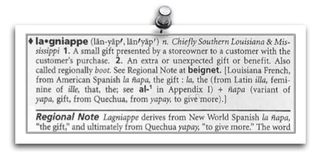April 10, 2009
 Drew's Note: As I try to do every Friday, I'm pleased to bring you a guest post. Meet another thought leader who shares his insights via the blogosphere. So without further ado…Dave Kahle. Again. Enjoy!
Drew's Note: As I try to do every Friday, I'm pleased to bring you a guest post. Meet another thought leader who shares his insights via the blogosphere. So without further ado…Dave Kahle. Again. Enjoy!
Are successful salespeople made or born? It is the eternal question: the sales manager's version of nature versus nurture.
Since I spend most of my time teaching salespeople how to become better at their jobs, I'm 100 percent in the "made" camp. There are best practices in the sales profession, and outstanding salespeople do many of the same things. A salesperson can, and should be, taught those best practices so they know how to do the job well.
Much of my practices consists of identifying and teaching the best practices to salespeople. I'm a believer in the notion that sales is a proactive profession – that you must first act, and then your actions get reactions. A good salesperson acts in the right way. His or her behavior is ultimately what determines his degree of success.
Thus, I believe that anyone can be taught the principles, processes and practices of effective sales. I like to characterize it like this: On a 1 – 10 scale, I can take 7s and make them into 10s. I can take 4s and make them into 7s. I can take 1s and make them into 4s. But I can't take 1s and make them into 10s.
As in every sophisticated endeavor, in the world of sales it sure helps if you have the aptitude and character with which to begin. "Character" is the operant word here. The Encarta Dictionary defines character as "the set of qualities that make somebody distinctive, especially somebody's quality of mind and feeling." In a common sense, we understand a person's character to be that combination of qualities, beliefs, tendencies and attitudes that give rise to his/her behavior.
It is the combination of characteristics that define who is the person. The practices and principles we teach instruct the person on what to do. While countless books and articles have addressed "what successful salespeople do", few have described "who successful salespeople are."
I don't claim to have the last word on this, nor do I believe that this group of characteristics is the whole story. But, from one person's perspective, here are my observations of the essential character traits of a successful salesperson.
The first characteristic that I see among successful people is this: They truly want to be successful. This isn't as simple and self–evident as it sounds. The world is mostly populated by people who don't want to be successful – at least not if it is going to cost them anything. Most people would like to have the benefit of success – the sense of confidence and competence, the material advantages, the respect and admiration of others – it's just that they aren't willing to accept the cost that is the inevitable prelude to success.
Success is almost always the result of a consistent, long range investment of time and energy on the part of the successful person. You must give something up if you want to be successful. For example, if you want to be home everyday to watch Oprah, and you won't give that up, you probably won't be successful. You're not willing to give up something in order to get something larger.
Successful salespeople want to be successful to the point they are willing to accept the costs and invest the time and effort that it takes to be successful. Thus, the success–focused salesperson works more hours than his average colleague. They try to make their first appointment for 7:45 a.m. and their last for 4:30 p.m. And when someone cancels, or the salesperson finds himself with unplanned downtime, he finds something productive to do.
Whereas most salespeople have not invested $20 in their own development in the last year, the success–seeking salesperson constantly buys the books, listens to the CDs, and attends the seminars in an attempt to gain more ideas and, therefore, shape his behavior more effectively. He/she is eager to learn from others, pays attention at sales meetings, and solicits his manager's input into his performance. He constantly thinks about his job, and continually tries to do it better.
This willingness to trade a short term pleasure and invest in themselves for the long term benefit is the first characteristic of a successful salesperson. Most just aren't willing to make the sacrifices that success calls on them to make.
I call characteristic number two "the ability and propensity to learn." For salespeople, I define learning as exposing yourself to new ideas, and then changing your behavior in positive ways as a result. Thus a successful salesperson is always looking for the next good idea, and continually experimenting with practices and behaviors that are designed to give him the best results.
This is the operating expression of the first characteristic. Whereas the desire for success supplies the energy and motivation, the ability and propensity to learn is one key way that motivation expresses itself.
Following this life–changing practice means that eventually every success–seeking salesperson is going to become exposed to the best practices of his profession, and every salesperson so inclined will eventually fold them into his/her routines. That means, equipped with this characteristic and given enough time, they are going to be successful. It is inevitable.
These two characteristics are so powerful and fundamental that they form the cornerstone of a success profile for a salesperson. The other characteristics which follow are derived from and expressions of these two characteristics.
For example, successful salespeople deal successfully with adversity. They don't let failure knock them off the path. They see failures and adversity as temporary stumbling blocks, and bounce back from every defeat. This is such a pronounced characteristic of successful salespeople that some authors hold it up as the single most outstanding characteristic of successful people.
It is this characteristic that causes them to make the second sales call after having been rejected in the first. It is this characteristic that stimulates the salesperson to approach just one more prospect, or visit this account one more time in spite of having failed previously.
It is this characteristic that prods the salesperson to bounce back from a failed marriage, a financial reversal, a bad experience with an employer, or a manager with whom he doesn't get along.
Motivated by his desire to succeed, and equipped with the ability to learn, he sees adversity as just another learning experience, and becomes more focused, wiser and more committed as a result.
The last of my big four characteristics is "the ability to focus." This is particularly important in our 21st Century economy. There are so many "things to do", so many opportunities and demands on our time, the unfocused salesperson can squander much of his day reacting to the superfluous.
Remember the movie "City Slickers?" When asked his secret for living a successful life, Curly held up one finger. "One thing" he said. Focus on one thing and do it well.
Very few people can do more than one thing exceptionally well. Sales is an incredibly sophisticated profession wherein real, long–lasting success takes years of disciplined work. Successful salespeople know that, and stay focused on the basics of their job, and the practices and principles that they know will pay off.
Given these four characteristics and enough time, the salesperson will become successful. When we find one of them, and then we add training in the principles and practices that define the best way to do the job, we have every reason to expect that person to develop into one of the successful superstars.
It starts with character.
Dave Kahle is the country's premier sales training educator. Since 1988, Dave has worked with over 400 companies, helping them to increase their sales and develop their sales people. He's been published over 1,000 times, writes a weekly Ezine, and has authored seven books. He has a gift for creating powerful training events that get audiences thinking differently about sales. Also, check out Dave's blog.
Every Friday is "grab the mic" day. Want to grab the mic and be a guest blogger on Drew's Marketing Minute? Shoot me an e-mail.
More
 Drew's Note: As I try to do every Friday, I'm pleased to bring you a guest post. Meet another thought leader who shares her insights via the blogosphere. So without further ado…MJ Ryan. Again. Enjoy!
Drew's Note: As I try to do every Friday, I'm pleased to bring you a guest post. Meet another thought leader who shares her insights via the blogosphere. So without further ado…MJ Ryan. Again. Enjoy!
![Reblog this post [with Zemanta]](http://img.zemanta.com/reblog_e.png?x-id=e5eb99ca-dceb-40eb-b4b2-61fb62f97ef3)

![Reblog this post [with Zemanta]](http://img.zemanta.com/reblog_e.png?x-id=3acc51ff-e4b2-4b79-807b-c1d57ae11519)








![Reblog this post [with Zemanta]](http://img.zemanta.com/reblog_e.png?x-id=4291e383-074d-46ba-9074-de9f5c30b936)